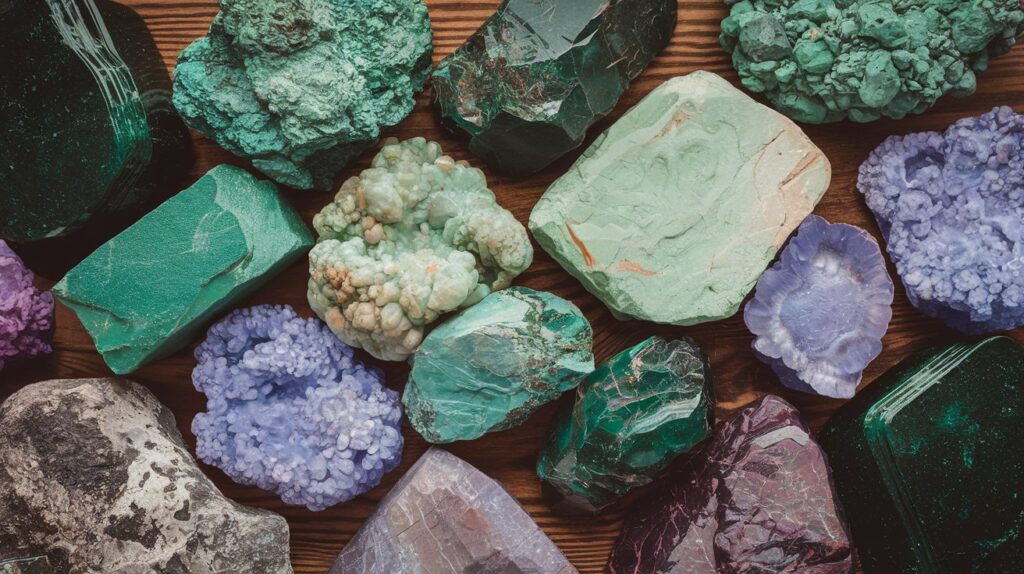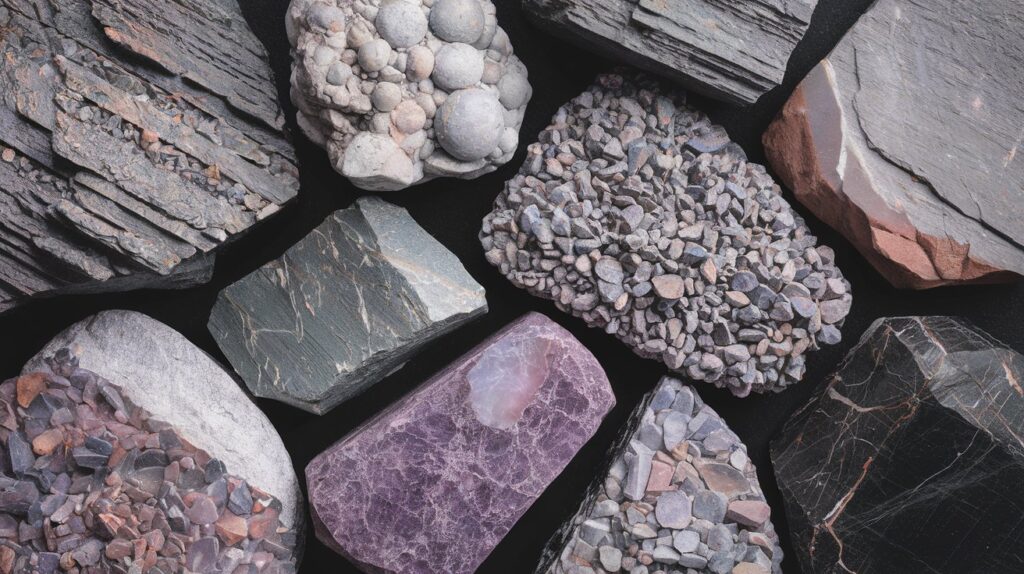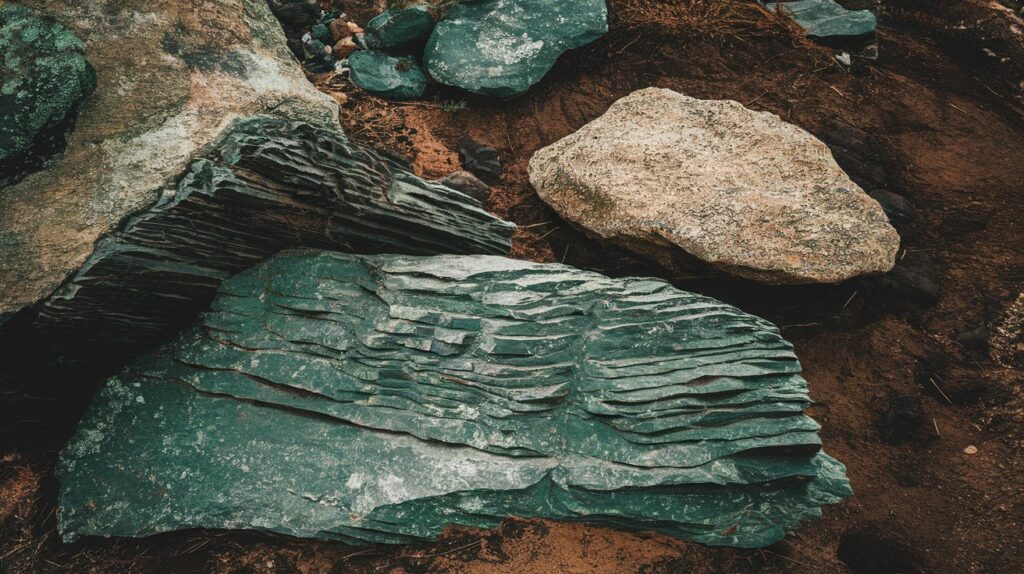
Metamorphic rocks are a fascinating part of the geological world, formed through the transformation of igneous and sedimentary rocks by intense heat and pressure. Unlike other types of rocks, metamorphic rocks undergo a dramatic change from their original forms, resulting in distinct textures, colors, and structures.
In this article, we will explore the world of metamorphic rocks, their formation process, types, uses, and much more. We’ll also provide answers to some of the most common questions people have about these unique rocks.
What Are Metamorphic Rocks?
At their core, metamorphic rocks are rocks that have undergone a significant transformation. They start as either igneous rocks or sedimentary rocks, and through the influence of heat, pressure, or both, they change form.
Metamorphic rocks are one of the three main types of rocks (the others being igneous and sedimentary), and they form when existing rocks—whether igneous, sedimentary, or even other metamorphic rocks—undergo changes due to extreme heat, pressure, or both. These transformations occur deep within the Earth’s crust, where the temperatures and pressures are intense enough to alter the mineral composition, texture, and structure of the rock, without actually melting it.
How Metamorphic Rocks Form
The process of forming metamorphic rocks is called metamorphism, which means “to change form.” This transformation happens in two primary ways:
- Heat: When a rock is exposed to high temperatures, typically due to proximity to magma or geothermal heat, the minerals within the rock become unstable. The heat causes the minerals to recrystallize or form new minerals without melting the rock completely. These new minerals are often more stable under the high-temperature conditions.
- Pressure: In addition to heat, the rock may experience intense pressure from being buried deep beneath the Earth’s surface or from tectonic forces, such as when plates collide. This pressure can compress the rock and cause its minerals to align in parallel layers, forming a new rock texture. In some cases, pressure can cause the rock to become denser and change its overall shape.
Together, heat and pressure cause profound changes in the rock’s mineralogy and structure, creating a metamorphic rock that can be significantly different from its original form.

Types of Metamorphism
There are two primary types of metamorphism, which define how metamorphic rocks form:
- Contact Metamorphism: This occurs when rocks are heated by nearby magma or lava. The high temperatures cause the minerals within the rock to recrystallize, forming new metamorphic rocks. Since the heat is localized around the magma, contact metamorphism usually affects only a small area. Marble is an example of a rock that forms through contact metamorphism, often from limestone.
- Regional Metamorphism: This occurs over a large area and is typically associated with tectonic processes, such as mountain-building. When tectonic plates collide, they exert enormous pressure on the rocks in the region, causing widespread metamorphism. Schist and gneiss are examples of rocks that form through regional metamorphism.
Textures of Metamorphic Rocks
The texture of a metamorphic rock is one of the most defining features, and it is largely influenced by the amount of pressure applied during the rock’s formation. There are two main types of metamorphic textures:
- Foliated Metamorphic Rocks: These rocks have a layered or banded appearance because the minerals within the rock have been realigned under directional pressure. The minerals often appear in parallel layers or stripes. Examples of foliated rocks include:
- Slate: Fine-grained and splits easily into thin sheets.
- Schist: Medium-grained, with a shiny, often wavy appearance due to large, visible mineral crystals.
- Gneiss: Coarse-grained with alternating light and dark mineral bands.
- Non-Foliated Metamorphic Rocks: These rocks do not have a banded or layered texture because they formed under conditions where pressure was equal in all directions, or the rock’s minerals do not easily align. Examples include:
- Marble: A fine-grained rock formed from limestone, used commonly in sculpture and architecture.
- Quartzite: A very hard rock formed from sandstone through recrystallization of quartz grains.
Examples of Common Metamorphic Rocks
Here are a few well-known metamorphic rocks and their parent rocks:
- Marble: Forms from limestone under heat and pressure. It is non-foliated and often used for statues and buildings.
- Slate: Forms from shale through low-grade metamorphism. It is foliated and commonly used for roofing tiles and blackboards.
- Gneiss: Forms from granite through high-grade metamorphism. It is foliated with distinct banding and is used as a decorative stone.
- Quartzite: Forms from sandstone through recrystallization of quartz. It is extremely hard and used in construction.
- Schist: Forms from mudstone or shale and has visible layers of minerals. It is a foliated rock with shiny, large mineral crystals.
The Importance of Metamorphic Rocks
Metamorphic rocks provide important clues about the conditions deep inside the Earth. They reveal information about the pressures, temperatures, and tectonic processes that have affected the Earth’s crust over time. Because they are formed under specific conditions, they help geologists understand Earth’s dynamic processes, such as the movement of tectonic plates and the formation of mountain ranges.
Uses of Metamorphic Rocks
Many metamorphic rocks are valued for their durability and aesthetic qualities. Some common uses include:
- Marble is prized for its beauty and is used in sculptures, flooring, and countertops.
- Slate is often used for roofing, flooring, and outdoor steps because it is durable and weather-resistant.
- Quartzite is used in construction due to its hardness and resistance to wear.
- Gneiss is used as a decorative stone for buildings and countertops.
Key Points about Metamorphic Rocks
- Metamorphic rocks are formed from existing igneous, sedimentary, or other metamorphic rocks through the processes of heat and pressure.
- They can be classified into two main categories: foliated (layered) and non-foliated (non-layered).
- Metamorphic rocks often have different appearances and textures compared to their parent rocks due to the unique conditions under which they form.
- They are commonly used in construction, art, and decoration due to their strength and beauty.
In summary, metamorphic rocks are essential components of the Earth’s crust, formed through intense geological processes. They undergo significant transformations that alter their appearance, texture, and composition, providing valuable insights into Earth’s history and serving many practical uses in human society.
Definition of Metamorphic Rocks
Metamorphic rocks are sedimentary or igneous rocks that have been changed by heat or pressure. The changes they undergo result in a variety of appearances, textures, and mineral compositions. Since metamorphic rocks come from pre-existing rocks, no two rocks may look exactly alike, and their appearances are often very different from one another.

The Word “Metamorphic”
The term “metamorphic” comes from the Greek words “meta”, meaning change, and “morph”, meaning form. Therefore, metamorphic literally means “changed form,” which perfectly describes the process these rocks undergo.
“Metamorphic rocks are the result of the Earth’s constant recycling process, turning one type of rock into another.”
How Are Metamorphic Rocks Formed?
The formation of metamorphic rocks takes place under intense conditions deep within the Earth’s crust. There are two key factors responsible for this transformation:
- Heat
- Pressure
Heat
Heat plays a crucial role in the metamorphism of rocks. When igneous or sedimentary rocks are buried deep beneath the Earth’s surface, they come into contact with intense heat, often from nearby magma. This heat causes the minerals in the rock to recrystallize, resulting in a completely new rock with different characteristics.
Example: Limestone under extreme heat turns into marble.
Pressure
Pressure, especially from tectonic forces, also contributes to the metamorphic process. The deeper the rocks are buried, the higher the pressure. This pressure can deform the rock, squeezing the minerals into new alignments and sometimes producing layered or banded appearances.
What is metamorphic rock and an example?
Metamorphic rock is a type of rock that forms from the transformation of existing igneous, sedimentary, or other metamorphic rocks under conditions of high heat and pressure. This process is known as metamorphism, which changes the mineral composition and texture of the rock without melting it.
How Metamorphic Rocks Form
The formation of metamorphic rocks typically involves two main factors:
- Heat: When rocks are buried deep within the Earth, they are subjected to high temperatures, often due to proximity to magma or geothermal activity. The heat causes the minerals within the rock to become unstable and undergo recrystallization, leading to the formation of new minerals.
- Pressure: In addition to heat, rocks also experience intense pressure, especially during tectonic activities such as mountain building. The pressure causes minerals to realign or deform, leading to a new structure and texture in the rock.
Characteristics of Metamorphic Rocks
- Texture: Metamorphic rocks can have various textures. They are typically classified as:
- Foliated: These rocks exhibit a layered or banded appearance due to the alignment of minerals under directional pressure. Examples include slate and gneiss.
- Non-Foliated: These rocks lack a distinct layering and usually have a more uniform texture. Examples include marble and quartzite.
- Composition: The mineral composition of metamorphic rocks can vary widely, depending on the original rock (parent rock) and the conditions under which metamorphism occurred.
Example of a Metamorphic Rock: Marble
Marble is a well-known example of a metamorphic rock. It is formed from the metamorphism of limestone, which is primarily composed of the mineral calcite. The process of metamorphism occurs under conditions of high heat and pressure, leading to the recrystallization of calcite into a denser, interlocking structure.
Characteristics of Marble:
- Appearance: Marble is typically white or light-colored but can have various colors and patterns due to impurities such as clay, silt, or iron oxides.
- Texture: It is non-foliated, meaning it does not have layered structures.
- Uses: Marble is prized for its beauty and is commonly used in sculpture, flooring, countertops, and architectural details. It is also used in the production of lime, which is an important industrial material.
Conclusion
Metamorphic rocks play a significant role in the geology of our planet. They provide important insights into the conditions present within the Earth’s crust and are valued for their unique properties and aesthetic qualities. Marble, as an example of a metamorphic rock, showcases the beauty and diversity that can arise from the metamorphic process.
Types of Metamorphic Rocks
There are two main types of metamorphic rocks, and they are classified based on their textures and structures:
1. Foliated Metamorphic Rocks
Foliated metamorphic rocks are those that have a layered or banded appearance. This texture forms due to the alignment of mineral grains under pressure. The minerals within the rock reorganize themselves in parallel layers, giving these rocks a unique striped look.
Examples of Foliated Metamorphic Rocks:
- Slate
- Schist
- Gneiss
“The layered appearance of foliated metamorphic rocks is often compared to the pages of a book, where each layer tells a different story of the rock’s history.”
2. Non-Foliated Metamorphic Rocks
Unlike foliated rocks, non-foliated metamorphic rocks do not have a layered structure. They form in environments where pressure is relatively equal in all directions, preventing the alignment of minerals. These rocks tend to have a more uniform texture.
Examples of Non-Foliated Metamorphic Rocks:
- Marble
- Quartzite
- Hornfels
Common Examples of Metamorphic Rocks
Here are some of the most well-known metamorphic rocks, along with their parent rocks and their characteristics:
| Metamorphic Rock | Parent Rock | Description |
|---|---|---|
| Marble | Limestone | Non-foliated, fine-grained, often white |
| Slate | Shale | Foliated, breaks into thin sheets |
| Quartzite | Sandstone | Non-foliated, very hard, often used in construction |
| Gneiss | Granite | Foliated, alternating light and dark bands |
| Schist | Mudstone or Shale | Foliated, contains large mineral crystals |
The Role of Heat and Pressure
Both heat and pressure play critical roles in the formation of metamorphic rocks. Here’s a deeper dive into how they work:
Heat
When rocks are subjected to extreme heat (usually from nearby magma), the minerals within them become unstable. This instability causes the minerals to change, and new minerals may form as a result.
- Recrystallization: Heat often causes the minerals in a rock to recrystallize. For example, calcite in limestone recrystallizes to form the interlocking grains of marble.
Pressure
Pressure from tectonic forces can also cause metamorphism. This pressure squeezes the minerals in the rock, causing them to realign or recrystallize into new forms.
- Realignment of Minerals: In some cases, pressure causes minerals to become aligned in the direction of the applied force. This process leads to the formation of foliated metamorphic rocks, like schist and gneiss.
Uses of Metamorphic Rocks
Metamorphic rocks are incredibly valuable and have a wide range of uses in everyday life. Some of their common uses include:
- Marble is widely used in architecture and sculpture due to its beauty and durability.
- Slate is often used for roofing tiles and flooring because it can be easily split into thin, flat sheets.
- Quartzite is used in the construction industry because of its hardness and resistance to weathering.
- Schist and gneiss are sometimes used as decorative stones in landscaping and construction.
Metamorphic Rock Cycle and Plate Tectonics
The rock cycle is a continuous process where rocks of one type are transformed into another. Metamorphic rocks form from existing igneous or sedimentary rocks when they are subjected to heat and pressure, usually deep within the Earth.
- Plate Tectonics: The movement of Earth’s tectonic plates plays a crucial role in the creation of metamorphic rocks. When tectonic plates collide, they force rocks to be buried deep within the Earth, where the heat and pressure needed for metamorphism occur.
Key Takeaways
- Metamorphic rocks are formed from existing igneous or sedimentary rocks that undergo changes due to heat and pressure.
- There are two main types of metamorphic rocks: foliated (layered) and non-foliated (non-layered).
- Common metamorphic rocks include marble, slate, gneiss, and quartzite.
- These rocks play an important role in construction, art, and the natural world.
- The rock cycle and tectonic plate movements are essential in the formation of metamorphic rocks.
Important Point
| NO. | Important Points |
| 1. | About Us |
| 2. | Contact Us |
| 3. | Disclaimer |
| 4. | Privacy Policy |
FAQs about Metamorphic Rocks
What is a metamorphic rock?
A metamorphic rock is a type of rock that forms when an existing igneous or sedimentary rock is transformed by heat, pressure, or both.
How does pressure affect metamorphic rocks?
Pressure forces the minerals in the rock to realign, often resulting in a layered or banded appearance, as seen in foliated metamorphic rocks.
Can metamorphic rocks form on the surface of the Earth?
No, metamorphic rocks typically form deep within the Earth’s crust where heat and pressure conditions are intense.
What is the difference between foliated and non-foliated metamorphic rocks?
Foliated metamorphic rocks have a layered structure, while non-foliated metamorphic rocks do not.
How does marble form?
Marble forms from limestone that has been subjected to intense heat and pressure.
What are common uses of metamorphic rocks?
Metamorphic rocks are used in construction, architecture, and art. Marble is commonly used in sculptures, while slate is often used for roofing.
What are the parent rocks of metamorphic rocks?
Igneous or sedimentary rocks are the parent rocks of metamorphic rocks.
What is the rock cycle?
The rock cycle is the process by which rocks are continuously transformed between the three main types: igneous, sedimentary, and metamorphic.
Can sedimentary rocks turn into metamorphic rocks?
Yes, sedimentary rocks can turn into metamorphic rocks when exposed to heat and pressure.
Why do no two metamorphic rocks look alike?
The formation process of metamorphic rocks is unique, and the changes they undergo depend on the original rock, the amount of heat and pressure, and the minerals involved.
See these too
- Read Also: Mesozoic Era: The Age of Dinosaurs and Ancient Earth, 248-65 Million Years Ago
- Read Also: Exploring Meander Scars: The Crescent-Shaped Remnants of River Channels
- Read Also: Understanding Meanders: The Curves and Bends of River Systems
- Read Also: What is Magma? Formation, Characteristics, and Role in Igneous Rock Creation
- Read Also: Mafic Rocks: Characteristics, Types, and Examples
